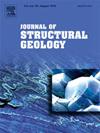Analysis of middle to deep-depth strike-slip faults in the southern Ordos Basin, China: A case study of the Xunyi area
IF 2.9
2区 地球科学
Q2 GEOSCIENCES, MULTIDISCIPLINARY
引用次数: 0
Abstract
High-resolution 3D seismic reflection data and coherence attribute analysis reveal a complex network of small-scale strike-slip faults (0.2–20 km in length) within the Xunyi area of the southern Ordos Basin at burial depths of 0.4–3.5 km. These structures exhibit a multi-phase evolution history characterized by distinct deformation patterns across different stratigraphic intervals.
Structural analysis identifies four distinct tectonic episodes: (1) initial development of NE and NW-trending fault systems during the Caledonian movement (Cambrian-Ordovician), (2) limited reactivation during the Hercynian event (Carboniferous-Permian), (3) formation of NWW to E-W-trending sinistral strike-slip faults during the Indosinian event (Early-Middle Triassic), and (4) right-lateral transpressional reactivation during the Yanshanian event (Late Jurassic-Early Cretaceous).
Mohr space analysis reveals that the angular relationship between fault orientation and regional stress fields fundamentally controls three distinct patterns of structural inheritance: (1) The XY1 fault maintains continuous activity through all tectonic phases due to its optimal N72-86°E orientation relative to successive stress fields; (2) The XY2-4 faults exhibit early termination after the Caledonian period despite their basement-cutting nature, attributed to their unfavorable orientation under subsequent stress regimes; (3) The Mesozoic faults (W1-4) initiated independently during the Indosinian period with N64-86°E strikes, displaying 33–44° counterclockwise rotation from pre-existing Paleozoic structures.
Detailed fault growth analysis reveals an early stress interaction mechanism where approaching fault segments develop secondary faults and displacement patterns before geometric overlap occurs. This observation challenges the traditional four-stage fault linkage model that assumes significant interaction only after substantial fault overlap, suggesting more complex stress field interactions during early fault development.
This integrated study provides critical insights into intraplate deformation processes within cratonic basins, demonstrating how the orientation of pre-existing structures relative to evolving regional stress fields fundamentally controls fault reactivation patterns in multi-phase tectonic settings.
鄂尔多斯盆地南部中深层走滑断裂分析——以旬义地区为例
高分辨率三维地震反射数据和相干属性分析揭示了鄂尔多斯盆地南部遵义地区在埋深0.4-3.5 km处存在一个复杂的小型走滑断层网络(长度为0.2-20 km)。这些构造呈现出多阶段的演化历史,在不同的地层层段具有不同的变形模式。构造分析确定了四个不同的构造时期:(1)加里东运动时期(寒武-奥陶世)NE - nw向断裂系统的初步发育,(2)海西期(石炭-二叠纪)有限的再活化,(3)印支期(早-中三叠世)NWW - e- w向左旋走滑断裂的形成,以及(4)燕山期(晚侏罗世-早白垩世)右向跨震再活化。Mohr空间分析表明,断向与区域应力场的角度关系从根本上控制了三种不同的构造继承模式:(1)XY1断裂相对于连续应力场的最佳N72-86°E方向使其在所有构造阶段保持连续活动;(2) XY2-4断裂虽具有基底切割性质,但在加里东期后终止时间较早,这是由于其在后续应力状态下的不利取向所致;(3)中生代断裂(w1 ~ 4)在印支期独立形成,走向n64 ~ 86°E,与已有古生代构造逆时针旋转33 ~ 44°。详细的断层发育分析揭示了早期应力相互作用机制,接近的断层段在发生几何重叠之前发育次生断层和位移模式。这一观测结果挑战了传统的四阶段断层联动模型,该模型假设只有在大量断层重叠之后才会有显著的相互作用,表明在断层发育早期,应力场的相互作用更为复杂。这项综合研究为克拉通盆地的板内变形过程提供了重要的见解,证明了在多期构造背景下,相对于演化的区域应力场,预先存在的构造方向如何从根本上控制断层再激活模式。
本文章由计算机程序翻译,如有差异,请以英文原文为准。
求助全文
约1分钟内获得全文
求助全文
来源期刊

Journal of Structural Geology
地学-地球科学综合
CiteScore
6.00
自引率
19.40%
发文量
192
审稿时长
15.7 weeks
期刊介绍:
The Journal of Structural Geology publishes process-oriented investigations about structural geology using appropriate combinations of analog and digital field data, seismic reflection data, satellite-derived data, geometric analysis, kinematic analysis, laboratory experiments, computer visualizations, and analogue or numerical modelling on all scales. Contributions are encouraged to draw perspectives from rheology, rock mechanics, geophysics,metamorphism, sedimentology, petroleum geology, economic geology, geodynamics, planetary geology, tectonics and neotectonics to provide a more powerful understanding of deformation processes and systems. Given the visual nature of the discipline, supplementary materials that portray the data and analysis in 3-D or quasi 3-D manners, including the use of videos, and/or graphical abstracts can significantly strengthen the impact of contributions.
 求助内容:
求助内容: 应助结果提醒方式:
应助结果提醒方式:


